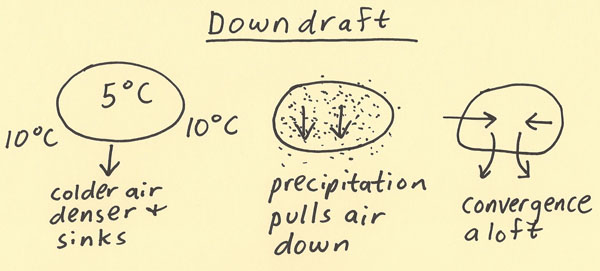
A thunderstorm has both an updraft and a downdraft. The downdraft is air that sinks from aloft to the surface. Often the downdraft brings cooler air and humid air to the surface. There are three processes that help contribute to a downdraft. The intensity of the downdraft will depend on the magnitude and prevalence of these factors. One factor that contributes to a downdraft is the downdraft air being denser than the surrounding air. Air is made denser by cooling it. Evaporation of moisture into the air cools the air aloft. The precipitation produced by the thunderstorm will help cool the air, especially where precipitation particles fall through dry air. The temperature difference between the downdraft air and the surrounding air will influence how strong the downdraft is. The greater the temperature difference then the stronger the downdraft. Another factor that contributes to a downdraft is the rain the hail falling toward the surface. The drag from the innumerable precipitation particles pulls air downward. Often thunderstorms have heavy precipitation and hail that helps pull air downward. A third factor is convergence of air aloft. The interaction between the thunderstorm and the surrounding air will produce convergence and divergence. Converge occurs where air streams come together. When convergence occurs aloft, some of the air will be forced down toward the surface. Thus, a downdraft results from colder/denser air sinking due to precipitation evaporating aloft, from the downward drag produced from falling precipitation and from convergence aloft.  |